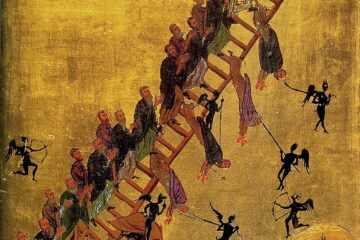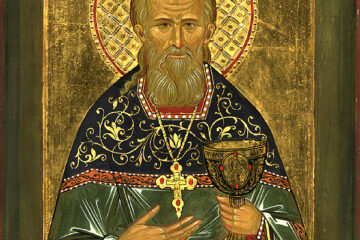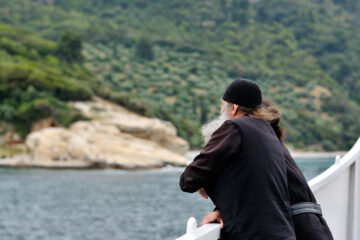The following in an excerpt from “Eros of Orthodoxy,” translated by Fr. Nicholas Palis and written by Mr. Pantelis Paschou.
By God’s grace, we have reached the end of the road, which our holy church established for her spiritual children with the opening of the Triodion. That is, to walk in ascesis and to fight against sin and the father of sin, satan. Whoever has crucified oneself, along with his passions and sinful desires, during these hours passes, with a secret gladness, by the crucifictory Triodion to the resurrection one. Whoever has followed the holy days of Great (Holy) Week-with the sacred Services of our Holy Church-the humiliations and Sufferings of the Lord, let them take the road by daybreak which the Myrrh bearers took, to hear the rejoice! from the mouth of their beloved Jesus. “And as we saw Him, hanging on the Cross, nailed hand and foot, fed vinegar and gall, crowned with thorns, pierced with a spear, having a dishonored face, killed by the sons of man (according to Isaiah) and bearing other sufferings as well for our own salvation. Today as well as many times we should see him mentally through faith, garbed as a groom with the very bright light of the Resurrection, coming out on the one hand from the tomb as from a bridal chamber, while on the other shining brighter than the sun”. And then, in the spring daybreak, and in the brightly shining dawn of the Resurrection whoever, like another Joseph of Arimatheas or Nikodemos-entombed Christ within him, will see the hard rocks of the tomb, his heart open up, and together with the Lord, will see his own world deadened by sin and worldliness, resurrect.
The philology around “the feast of feasts” and “celebration of celebrations” is infinite. On no other feast has so much been written in our Orthodox Church, as on the feast of Easter, the Resurrection of our Christ. Because the Eastern Orthodox Church, seems to have sprung forth, entirely, radiant, and spotless from within the great mystery of the Resurrection. And it is this that above all characterizes her. We shall hone-in on only a few points, from ecclesiastical philology that the light of the Resurrection bore as the real inspirer of every great poet and every great deed.
* * *
Passing the 3rd ode of the Easter canon (whoever leaves hurriedly after the celebration of the Resurrection, doesn’t experience) we hear a short lined Troparion that has everything in it, literally rejoicing and being glad in Christ’s arising, intoxicated in the light of the resurrection.
Now everything is filled with light,
heaven and earth and the underworld.
Therefore let all creation celebrate
Christ’s arising, in which it is secured.
The ending is given in two forms: either “in which it is secured” (i.e. in Christ) or “in which she is secured” (creation in other words in the arising, the resurrection.) Most likely no one else could evoke so much in so few words. And it is noteworthy to mention here what has been preserved for us relating to that Troparion of St. Nikodemos the Haghiorite. It is well known, that in parallel with the canon of St. John Damascene other hymnographers as well dedicated canons to holy Easter. In the library of the Vatopedi Monastery at Mount Athos, a canon is preserved with the topic the joyous Resurrection of the Lord, to be chanted in the 2nd tone, a poem of the breathtaking hymnographer, divine Kosmas. A tradition of the sacred Fathers mentions that, when they wrote them, first sacred Kosmas read his own canon. And John Damascene who heard it praised him. Afterwards however when Damascene took and read his own resurrection (the one known today) canon, and reached the Troparion. “Now all is filled with light, Heaven and earth and the underworld, both heaven and earth and the underworld.” Divine Kosmas with manifest and unrestrained admiration, stopped John and said: “And you, brother John have included the whole of everything, in these three, leaving nothing out. Thus I concede defeat. Hence let your canon have the privileged first place, and let it be chanted in the Churches of Christ. Let mine remain in a corner and in darkness, not worthy of light, both for its thoughts and for the mournful and plaintive tone in which it was composed, totally unfitting to the most bright joy of the world, the Resurrection of the Lord.”
And thus Damascene’s joyous canon remained to be chanted in the Orthodox Church, which proclaims the joy of the heavenly ones, the earthly ones and the underworld. The underworld rejoices because Christ, descending to Hades “has crushed the eternal bonds” and has “broken asunder the locks of death” delivering the age old prisoners. The earthly ones rejoice because they were united with the heavenly. The joy of the heavenly ones sacred is described for us by Chrysostom. “Today is joy on earth, today is joy in Heaven. For if there is joy on earth and in Heaven for one sinner returning, there is much more joy in Heaven over the whole world torn from the hands of the devil. Now Angels leap for joy, now the Archangels rejoice, now the Cherubim and Seraphim celebrate with us the present feast.”
However, in the panegyric and joyous sermons of Easter, the Christian mustn’t forget that the light of Resurrection that enlightens the earthly and the heavenly and the underworld is unable to violate our freedom and to enlighten the darkness that we zealously hide in us, like some precious treasure. Satan whispers to us, that the darkness of our inner world, which binds our material and spiritual senses, is really the guarantee for our free, unbound sensorial and sensuous life! But in this moldy and filthy darkness, which the senses drag like worms and like the most abominable serpents in the mind, how can the heart see the unapproachable light of the Resurrection? Without a pure heart no one will be granted to see God, Saint John Damascene invites us to become more spiritual celebrators of the Resurrection, by purifying our hearts and senses to be granted to see the light of Christ, and to clearly hear inside us the rejoice which He said to the pure Myrrh bearers. Note the celebration of the Resurrection not in words but by deeds that are results of sanctified senses and a resurrected heart–it is precisely that which we must greatly stress today. How much of the spirit of the Resurrection enters our life, according to the teaching of the Holy Scripture and the Holy Fathers of our Church? “The spirit of the Resurrection, says a current Orthodox theologian, which is the Spirit of the life of the age to come, must illumine the life of the members of the Church. When the Church doesn’t have such members, it is a museum with incomprehensible icons and expressions, since there is no one to explain them to the idol-worshipping world, which awaits the light of Christ. Because the only manner which the dogma and the worship life of our Church can declare the Lord’s Resurrection, is in the manner of works and of life. If someone today attempts to explain the spirit of the Resurrection to the world in words, not only will he not be heard, but he will bring about indignation as well. The world has had its fill of conversations with sacred content. The Resurrection of the Lord is “in power”. Only the language of works can speak to the soul of the world today. Here is the great responsibility of today’s Christians before God and the Church.” (St. Agourides, “Responsibility” Vol. 1 1961 p. 26).
The following words of Saint Nikodemos the Haghiorite, are written in this spirit with which we will close this discourse: “We have been co resurrected with the risen Christ, and both by faith and through holy Baptism, through the form of the burial and Resurrection of the Lord. Therefore, may we live a new life, which is proper for those who have coresurrected with the Master Christ, as Paul commands us “So that, as Christ arose from the dead, through the glory of the Father, thus let us also walk in newness of life”. (Rom 6:4). Today we learned from the risen one a new life. So let us keep this till the end, having new thoughts, speaking new words, and doing new deeds, worthy of the new Resurrection of Christ”.



0 Comments